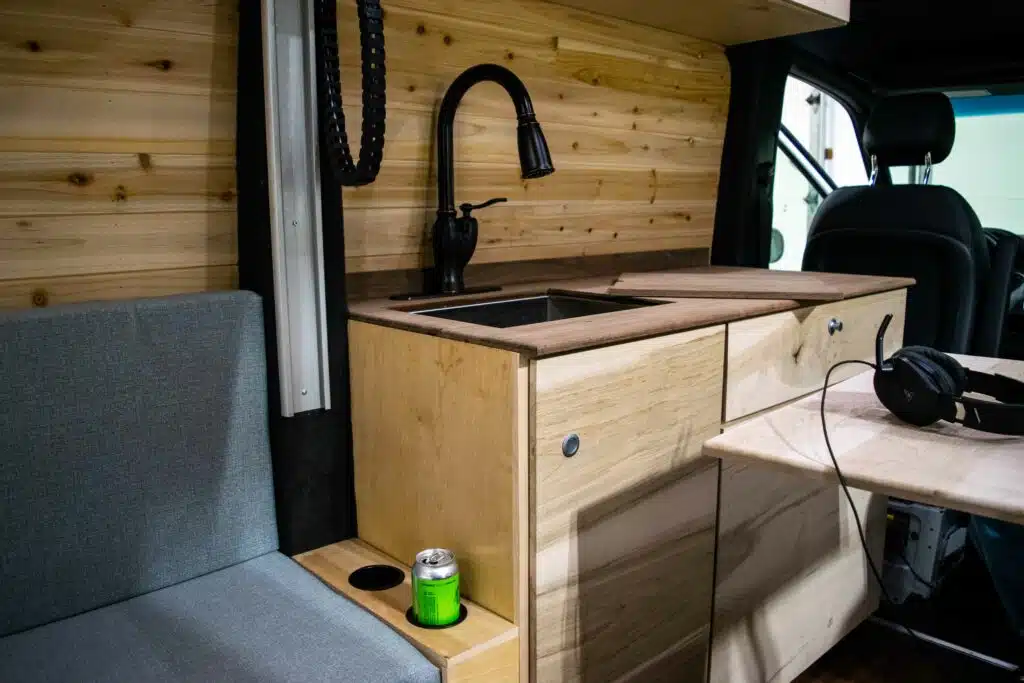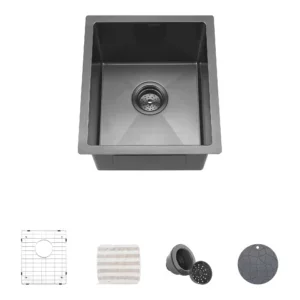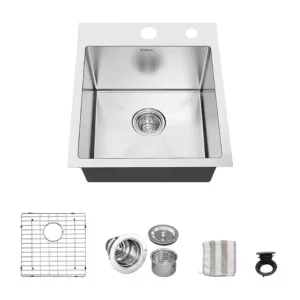The Mechanics Behind RV Sinks
If you are getting into the world of RVs as a newbie, this section will help you understand how sinks work in RVs. RV sink faucets are linked to the freshwater system in your RV. This system can draw water from freshwater tanks using a pump. But it is also easily connected to the city water using a cove over the outside of your RV van.
Both methods will let you have fresh running water in your RV sink when you open the faucet. Suppose you pick to hook the RV to the city water. In that case, you only need to connect the water pressure regulator to the freshwater supply, connect your regulator and tube on the outside spigot, and then connect the other end to the city water inlet. Then, you can turn the water on over the faucet. After this process, you will have water on your RV sink, and anywhere you have a water supply in the RV.
If you are dry camping, you will need water to fill your water tank on a potable water spigot before you leave for your campsite. Your water supply fill is over the outer side of the RV and is labeled accordingly. Once your tank is filled up, you must turn the pump on before you open the tap to use the running water in the sink.
Navigating RV Sink Features
RV sinks come with different faucets linked to RV’s freshwater system. The whole system can pull up water from the tanks using the pump available, but it might also be linked to the city water using an inlet outside of the RV. Either of these methods will let you have running water through your RV sink in the RV when you open the faucet.
Suppose you choose to hook your RV to the city water. Then, you will only have to attach the water pressure regulators to the freshwater hose and connect this regulator and hose over the outsides of the spigot and then connect the other side of your city water inlet and turn the water on the spigot. After doing this, you will have fresh water in your RV sink.
You can install water heaters in your sink to heat the water. This is an easy-to-operate ignition system that the heater will turn on when the water temperature drops too low. These units have self-regulation temperature sensors; hence, you will not have to worry about turning this system off when it isn’t in use.
City Water VS. Freshwater Tank
City water
One of the ways to have running water in your faucet is to attach the RV water hose using a spigot to the water inlet over the outsides of your rig. This is known as city water. With this city water method, you won’t have to fill your RV’s holding tank or fresh water. You will also not have to use the pump.
Using the city water method, all of the water goes from this hose directly into the pipes, which leads to your RV toilet, RV sink, faucets, and shower head. City water bypasses the water holding tank completely. When using city water, you should keep the outside water spigot active and on at all times. This way, the water pressure coming from the spigot pushes water through the RV water system.
So there’s no need to use the built-in water pump. Turning off the spigot when you’re not using the water prevents potential leaks in the RV plumbing system. Using city water will for sure work if there are nearby fixtures that you can use.
Freshwater
RV fresh water connection is a simple way of adding potable water to fill up the fresh water tank in your RV. Mostly, freshwater connections are gravity-filled, which means there is an opening on the sides of the RV to fill up the tank with fresh water. Technically, this might not be a connection, as the hose isn’t screwed over it. But it is also the route that the freshwater follows over the fresh tank.
This is mainly done by aiming the end of the drinking water-safe hose into the opening of direct water in the freshwater holding tank that will fill it up. Water may also be added directly in the gravity fill opening from the portable container or the water bladder.
In most RVs, fresh water and city water connections are considered separate. So there are mainly two connections, one of which is the port for filling the freshwater tank. The other connects the RV plumbing system to the pressurized city water supply. But in some RVs, there is only one connection for water. So, the rig only has one way to attach to the water supply: a single-threaded connection that pressurizes the plumbing and fills in the fresh tank.
The hose links up the city water supply on the campground. The diverter valve controls the end destination of the water, which either fills up the fresh water tank or pressurizes the plumbing system.
The Significance of Graywater Tanks
Most people who are still new to the RV world will not have a clear idea of the usage and purpose of the RV gray water tank. Holding tanks in the RV manages the wastewater demands in all transportable locations, similar to how many residences have sewer and plumbing systems.
Your RV sink plumbing and sewage are all handled by the freshwater tanks, the gray water tank, and the black water tank. Fresh and black water tanks are used for fresh water and wastewater from toilets, but most people are also confused about what this tank is used for.
What is a Gray Water Tank in an RV?
This is a holding tank in which your RV sink and indoor shower drain are called the RV gray water tank. This gray water is the same in your RV except for the toilet water. The gray tank collects this water from the kitchen, indoor shower, and bathroom sink. The wastewater drains into this gray tank when cleaning your dishes in the sink or brushing your teeth in your bathroom.
In larger RVs, washing machines and dishwashers typically drain into the gray tank, which can quickly fill up. So, most RV washing machines have specific warnings that must only be used when connected to the sewer line on a campground or an RV resort.
How to Clean the RV Gray Water Tank?
You may do some things to keep the RV gray water tank perfectly clean. You might start even long before the water is switched on by reducing the total amount of food rinsed off the drain in the kitchen sink. All food residues you might remove from the dishes before washing them also means less will be rinsed into the drain, which will help keep the gray tank cleaner.
You may do some basic things if you have smell issues with the gray water tank. When this gray tank has half a tank of water, you should buy dishwasher detergent and pour a cup into the galley sink one day before travel. Once you drive, the detergent solution may splash around and sit for some time. Emptying the gray water tank can help flush away any residual material and clean the tank’s interior.
When it comes to dumping gray water tanks, instead of choosing stealth dumping options, you should be sure to dump them in the specific city sewage connection. If you see a stench releasing from the sink, consider adding odor-controlling chemicals to your gray water tanks.
Conclusion
The RV sink is an essential vehicle component that provides a convenient and hygienic way to wash dishes, prepare food, and maintain personal hygiene while on the road. You must know a few things about your RV system’s water supplies and sinks. Regularly checking your RV sink ensures a smoother journey on the road.
The RV sink is evidence of modern engineering, providing a dense and efficient means of bringing the comforts of home on the road. Regular maintenance and responsible water usage are critical factors in ensuring the sink’s continued functionality and preserving valuable freshwater resources.









